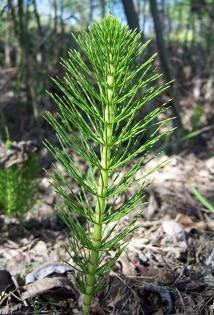
Dr. Lew Feldman, Garden Director
Horsetail (Equisetum telmateia)
An invasive weed, but also useful in many ways!
Horsetail (Equisetum telmateia) is found throughout the Garden, generally as an invasive, aggressive weed. But what truly distinguishes horsetail is that it is rich in the mineral silicon (silica), which contributes to cell wall rigidity and to the strengthening of the plant, and which also gives the plant a gritty, sandpaper-like feel that is the basis for another common name, “scouring rush”.
Many uses from domestic to medicinal
In historical times, Equisetum plants were used for scouring pots and for polishing pewter. Historical and contemporary uses of horsetail also relate to its use in medicine. Researchers believe that medicinal properties of horsetail are due to its high silica content, which can amount to as much as 25% of the dry weight of the plant. According to practitioners of folklore medicine, horsetail could be used as a treatment for various conditions, including for tuberculosis, for pulmonary and gastric hemorrhages and even for brittle fingernails and loss of hair. In more modern times there are numerous reports that silicon-containing extracts from horsetail promote the growth and stability of the human skeletal structure and also have a use in treating various bone diseases, particularly osteoporosis. Along these same lines, there are a few studies which have shown that fractured bones heal more quickly when an extract from horsetail is ingested.
Thus, even though we think about horsetail mainly for its invasive nature, the plant has an otherwise rich history of involvement in human affairs.
